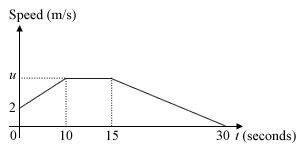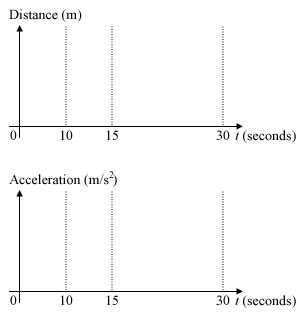 What’s the difference between the Kinematics question below and the previous one?
What’s the difference between the Kinematics question below and the previous one?
Just like stubborn Physics students who insist on using their super duper rocket science motion equations to attempt A-Maths kinematics questions, equally-stubborn A-Maths students will insist on using their Level 99 magical differentiation and integration powers to tackle E-Maths kinematics.
These Paper 1 questions usually take up a paltry 6 marks. Though it’s still around 7-8% of your overall Paper 1 score, Miss Loi thinks you should save up your ultimate Level 99 skills for the bosses later.
So what exactly is the difference? … Graphs!

The diagram is the speed-time graph for the first 30 seconds of the motion of an object.
- Given that the distance covered by the object in the first 10 seconds is 60 metres, find the value of u.
- Find the speed of the object after 16 seconds of motion.
- On the axes given below, draw
- the distance-time graph for the first 30 seconds of the motion of the object.
- the acceleration-time graph for the same 30 seconds.

Having sacrificed their work-life balance to painstakingly churn out these graphs on (heaven forbids) MS Word, do you seriously think the examiners (and Miss Loi) are going to simply let you ‘off the axes’?
Once again, think about those who don’t take A-Maths for a schooling. Concept of gradients, similar triangles etc. are some of the rudimentary Level 1 powers they have at their disposal 🙂
P.S. It is imperative you already possess the Level 2 skills of deducing Speed-Time, Distance-Time and Acceleration-Time graphs from each other when you attempt this. And please don’t fall into the trap of getting stuck in the overrated speed = distance/time thingy. We don’t draw the graphs for fun!



 Miss Loi is a full-time private tutor in Singapore specializing in O-Level Maths tuition. Her life’s calling is to eradicate the terrifying LMBFH Syndrome off the face of this planet. For over years she has been a savior to countless students …
Miss Loi is a full-time private tutor in Singapore specializing in O-Level Maths tuition. Her life’s calling is to eradicate the terrifying LMBFH Syndrome off the face of this planet. For over years she has been a savior to countless students … 





















7 Comments
曜
日
1st answer is 4.
2nd one if i am lucky is 4 - 1/16 = 64/16 - 1/16= 63/16 = 3 15/16!
i dont know the rest 😛 how are you going to release ans?
(i'm one of the few who don't take amaths.geez..)
曜
日
winston ... ummm ... don't think you're lucky this time. Read the red text dude!
曜
日
1. u = 10 m/s
2. 9 and 1/3 m/s
3a. starting from zero, a curved line with an increasing slope, followed by a straight line with constant slope, then lastly a curved line with a decreasing slope.
3b. horizontal line at a=0.8, followed by horizontal line at a=0, lastly horizontal line at a= -2/3
hopefully my mental calculations aren't too hopelessly wrong.
曜
日
Great work Ms Lala! Can Miss Loi assume that you mental calculations were done with the help of the graph?
Next time don't forget to write down your working (even though Miss Loi knows they're all on your head!).
So to complete your answers with some explanations:
1. In a speed/time graph, the distance covered in 10 sec will be the area under the graph bounded by 0 ≤ t ≤ 10, which is the area of a trapezium (see shaded portion below).
Hence solve for:
(1/2)(2 + u)(10) = 60
Hope students still remember the formula to find the area of a trapezium!
2. Let the speed be x at 16 seconds. If you draw some lines on the relevant coordinates, you'll actually come face to face with two similar triangles (see the shaded portion below):
Hence solve for x:
(10-x)/x = 1/14
3. Hope Miss Loi's sketching skills are good enough to illustrate your 'descriptive' answers for clarity:
As mentioned in the main entry, students really, really need to understand the concepts of gradients in different graphs.
Also remember to label all points on the axes (i.e. distance) else marks might be lost!
曜
日
i think that the information given is not enough T.T
曜
日
At a levels.. this is about all the info you get and its a physics mcq question...So the information is sufficient actually. ^_^
Moral of the story, If u cant handle this,don't choose A levels go poly! Trust me its not worth the tears of blood shed X_X.
曜
日
can i use this formula for question 2 to find speed?
v-final speed
u-initial speed
a-acceleration
t=time
Formulae:v=u+at